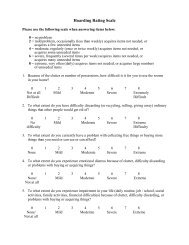

Background: The Fahn-Tolosa-Marin Clinical Rating Scale for Tremor (FTM) has been used in large trials for essential tremor (ET), but its anchors for ratings from 0 to 4 of upper limb tremor are probably too low for patients with severe tremor (tremor amplitude >4 cm; grade 4). The Essential Tremor Rating Assessment Scale (TETRAS) is a validated clinical scale designed specifically for the assessment of ET severity. TETRAS has anchors that span a larger range of tremor amplitudes (>20 cm = grade 4), making it more suitable for assessing patients with severe ET. However, there is no direct comparison of these scales in any clinical trial. Methods: Upper limb postural and kinetic tremor items from both scales were compared using blinded, video-recorded examinations of patients with moderate-to-severe ET who participated in a trial of focused ultrasound thalamotomy. Results: FTM ratings of postural and kinetic tremor correlated strongly with those of TETRAS.
However, FTM exhibited a ceiling effect for severe tremor. Rest tremor, exclusive to FTM, correlated poorly with postural and kinetic tremor and had very poor test-retest reliability. In contrast, wing-beating postural tremor, exclusive to TETRAS, exhibited excellent test-retest reliability and a strong correlation with kinetic and limbs-extended-forward postural tremor. Test-retest reliabilities of the other TETRAS and FTM ratings were excellent, and both scales had good sensitivity to treatment effect. Battlefield 4 complete edition repack by corepack. Conclusions: TETRAS has 2 main advantages over FTM in the assessment of tremor severity: (1) the absence of a ceiling effect in patients with severe ET, and (2) the inclusion of wing-beating tremor.
Tremor-dominant form. Marked disabling tremor of at least level 3 or 4 on the Fahn-Tolosa-Marin Clinical Tremor Rating Scale (or equivalent scale) in the extremity intended for treatment, causing significant limitation in daily activities despite optimal medical therapy.
Abstract = 'Background: The Fahn-Tolosa-Marin Clinical Rating Scale for Tremor (FTM) has been used in large trials for essential tremor (ET), but its anchors for ratings from 0 to 4 of upper limb tremor are probably too low for patients with severe tremor (tremor amplitude >4 cm; grade 4). The Essential Tremor Rating Assessment Scale (TETRAS) is a validated clinical scale designed specifically for the assessment of ET severity. TETRAS has anchors that span a larger range of tremor amplitudes (>20 cm = grade 4), making it more suitable for assessing patients with severe ET. However, there is no direct comparison of these scales in any clinical trial.Methods: Upper limb postural and kinetic tremor items from both scales were compared using blinded, video-recorded examinations of patients with moderate-to-severe ET who participated in a trial of focused ultrasound thalamotomy.Results: FTM ratings of postural and kinetic tremor correlated strongly with those of TETRAS. However, FTM exhibited a ceiling effect for severe tremor. Rest tremor, exclusive to FTM, correlated poorly with postural and kinetic tremor and had very poor test-retest reliability. In contrast, wing-beating postural tremor, exclusive to TETRAS, exhibited excellent test-retest reliability and a strong correlation with kinetic and limbs-extended-forward postural tremor.
Test-retest reliabilities of the other TETRAS and FTM ratings were excellent, and both scales had good sensitivity to treatment effect.Conclusions: TETRAS has 2 main advantages over FTM in the assessment of tremor severity: (1) the absence of a ceiling effect in patients with severe ET, and (2) the inclusion of wing-beating tremor.' TY - JOUR T1 - Comparison of the Fahn-Tolosa-Marin Clinical Rating Scale and the Essential Tremor Rating Assessment Scale AU - Ondo, William AU - Hashem, Vera AU - LeWitt, Peter A AU - Pahwa, Rajesh AU - Shih, Ludy AU - Tarsy, Daniel AU - Zesiewicz, Theresa AU - Elble, Rodger PY - 2018/10/27 Y1 - 2018/10/27 N2 - Background: The Fahn-Tolosa-Marin Clinical Rating Scale for Tremor (FTM) has been used in large trials for essential tremor (ET), but its anchors for ratings from 0 to 4 of upper limb tremor are probably too low for patients with severe tremor (tremor amplitude >4 cm; grade 4). The Essential Tremor Rating Assessment Scale (TETRAS) is a validated clinical scale designed specifically for the assessment of ET severity. TETRAS has anchors that span a larger range of tremor amplitudes (>20 cm = grade 4), making it more suitable for assessing patients with severe ET. 
However, there is no direct comparison of these scales in any clinical trial.Methods: Upper limb postural and kinetic tremor items from both scales were compared using blinded, video-recorded examinations of patients with moderate-to-severe ET who participated in a trial of focused ultrasound thalamotomy.Results: FTM ratings of postural and kinetic tremor correlated strongly with those of TETRAS. However, FTM exhibited a ceiling effect for severe tremor. Rest tremor, exclusive to FTM, correlated poorly with postural and kinetic tremor and had very poor test-retest reliability. In contrast, wing-beating postural tremor, exclusive to TETRAS, exhibited excellent test-retest reliability and a strong correlation with kinetic and limbs-extended-forward postural tremor.
- Author: admin
- Category: Category